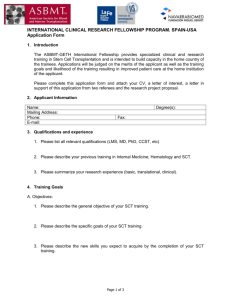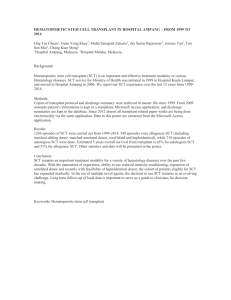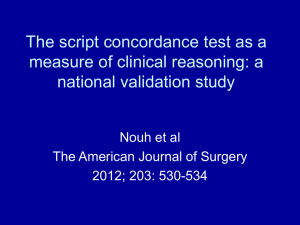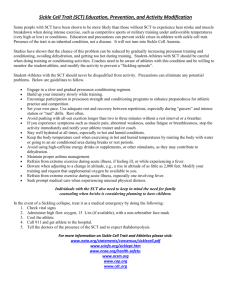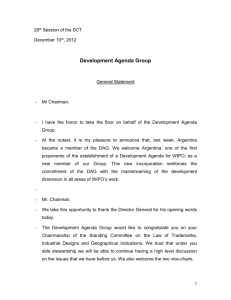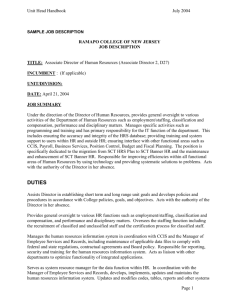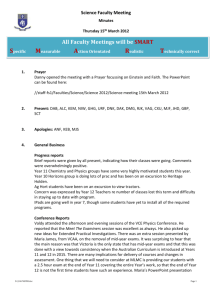ASBMT Evidence-Based Reviews - American Society for Blood and
advertisement
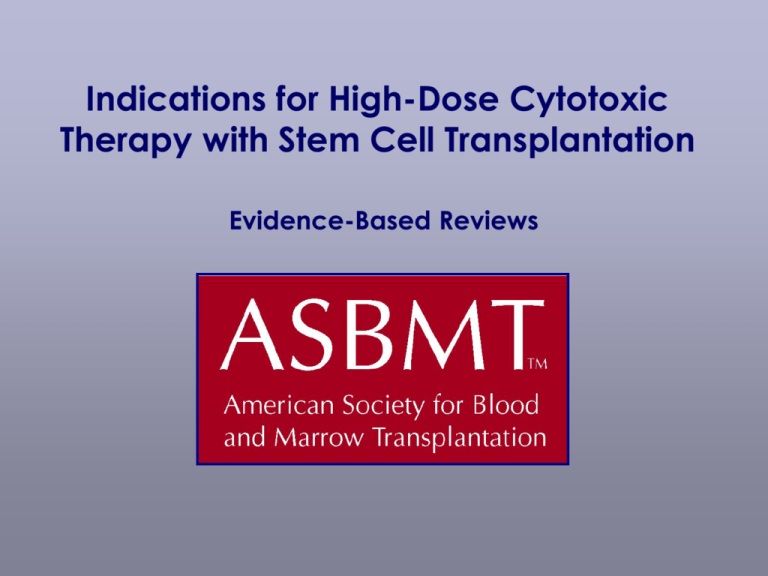
Indications for High-Dose Cytotoxic Therapy with Stem Cell Transplantation Evidence-Based Reviews ASBMT Evidence-Based Reviews “The practice of evidence-based medicine means integrating individual clinical expertise with the best available external clinical evidence from systematic research.” Sackett, D.L. et al. Evidence-based medicine: what it is and what it isn't. BMJ 1996;312:71-72. ASBMT Evidence-Based Reviews Goals Define accepted medical practice Promote evidence-based decisions Improve treatment outcomes Determine areas of needed research ASBMT Evidence-Based Reviews Steps Assemble evidence for selected diseases Evaluate strength and quality of the evidence Identify discrepancies in study design or methodology Make treatment recommendations Recommend areas of needed research Advocate best treatment for all patients Improve access/reimbursement Inform patients, providers, and payers ASBMT Evidence-Based Reviews Benefits of Evidence-Based Medicine Improved Patient Care Aid treatment decisions of referral physicians and their patients Assist in reimbursement policies and decisions Enhance technology assessment Identify areas of needed research Foster quality of study design/methodology Document best practices/standards of care ASBMT Evidence-Based Reviews The Review Process ASBMT Steering Committee Establishes criteria for grading evidence and inclusion/exclusion criteria for evidence Maintains standards of evidence-based medicine Identifies diseases for review Nominates expert panelists for each review ASBMT Evidence-Based Reviews The Review Process Expert Panel for Each Disease Transplant specialists Disease-specific experts for non-transplant therapies Third-party payer Patient advocate ASBMT Evidence-Based Reviews The Review Process Expert Panel for Each Disease Identifies areas of inquiry/parameters of review Guides and advises literature search, writing Evaluates strength/quality of evidence Reaches consensus on treatment recommendations Recommends areas for further study ASBMT Evidence-Based Reviews Completed Evidence-Based Reviews • Acute Lymphoblastic Leukemia in Children (2005, updated 2012) • Acute Lymphoblastic Leukemia in Adults (2006, updated 2012) • Diffuse Large B-Cell Non-Hodgkin Lymphoma (2001, updated 2011) • Follicular Lymphoma (2010) • Myelodysplastic Syndromes (2009) • Acute Myeloid Leukemia in Adults (2008) • Acute Myeloid Leukemia in Children (2007) • Multiple Myeloma (2003) ASBMT Evidence-Based Reviews Future Directions • Periodic updating of completed reviews based on evolving standards and new scientific evidence. • Acute Myeloid Leukemia in adults - update in 2012 • Acute Myeloid Leukemia in children update in 2012 ASBMT Evidence-Based Reviews EBR Update Process • Updates occur in the same order as the publication of original EBRs, unless there is a substantial reason to change the order of a specific review • The original expert panel is invited to participate in the update • New evidence is presented in summary tables along with high level evidence from the original EBR • Updated Treatment Recommendations indicate whether new evidence strengthens, weakens, or does not change the original recommendations ASBMT Policy Statement on updating published EBRs: Biology of Blood and Marrow Transplantation (Vol. 15:761-762) June 2009 ASBMT Evidence-Based Reviews “The Role of Cytotoxic Therapy with Hematopoietic Stem Cell Transplantation in the Therapy of Pediatric Acute Lymphoblastic Leukemia (ALL): Update of the 2005 Evidence-Based Review” Biology of Blood and Marrow Transplantation 2012, in press. ASBMT Evidence-Based Reviews ALL in Children RECOMMENDATIONS • Allogeneic SCT is recommended for pediatric ALL patients who experience primary induction failure, but subsequently achieve a first complete remission (CR1); new evidence has changed the original recommendation • Allogeneic SCT is recommended for pediatric patients with precursor-B ALL in CR2 after an early marrow relapse; new evidence has changed the original recommendation ASBMT Evidence-Based Reviews ALL in Children RECOMMENDATIONS • Allogeneic SCT is recommended for pediatric Tlienage ALL patients in CR2 after a marrow relapse; this is a new recommendation based on evidence in the original review and expert opinion • Allogeneic SCT is recommended for pediatric patients with ALL in CR3 or greater; this is a new recommendation based on new evidence ASBMT Evidence-Based Reviews ALL in Children RECOMMENDATIONS • Allogeneic SCT may be considered for some patients with T-lineage ALL in CR1; this is a new recommendation based on new limited evidence and expert opinion. • Allogeneic SCT may be considered for children with hypodiploid ALL (<44 chromosomes) in CR1; this is a new recommendation based on expert opinion ASBMT Evidence-Based Reviews ALL in Children RECOMMENDATIONS • Allogeneic SCT may be considered for patients with ALL in CR1 or CR2 who have minimal residual disease detected by a validated assay; this is a new recommendation based on expert opinion • Allogeneic SCT may be considered for patients with ALL who are not in morphologic CR; this is a new recommendation based on expert opinion ASBMT Evidence-Based Reviews ALL in Children RECOMMENDATIONS • Allogeneic SCT and chemotherapy provide equivalent outcomes for pediatric precursor-B ALL patients in CR2 after experiencing a later marrow relapse; new data have changed the original recommendation • Allogeneic SCT and intensive chemotherapy with imatinib have equivalent early outcomes for Ph+ ALL in CR1; new evidence changed the original recommendation. Further study is needed in this area ASBMT Evidence-Based Reviews ALL in Children RECOMMENDATIONS • Allogeneic SCT is not recommended for an isolated CNS relapse in precursor-B pediatric ALL patients; this is a new recommendation based on new evidence • Autologous SCT is not recommended in CR1; this is a new recommendation based on new evidence ASBMT Evidence-Based Reviews ALL in Children RECOMMENDATIONS • Allogeneic SCT is not recommended when MLL+ ALL is the sole adverse risk factor; this is a new recommendation based on new evidence. The presence of MLL+ along with other adverse risk factors (older age, high WBC, prednisone response, other cytogenetic abnormalities) has been used to define very high risk subgroups for which allogeneic SCT may be recommended ASBMT Evidence-Based Reviews ALL in Children ALLOGENEIC SCT TECHNIQUES • Myeloablative Total Body Irradiation (TBI) containing conditioning regimens are recommended; new data have strengthened the original recommendation • HLA-matched related and unrelated donors provide equivalent outcomes. In the absence of an HLA-matched related donor, an HLAmatched unrelated donor (using marrow, peripheral blood or cord blood ) is acceptable for allogeneic SCT; this is a new recommendation based on new evidence ASBMT Evidence-Based Reviews ALL in Children ALLOGENEIC SCT TECHNIQUES • Allogeneic SCT using the best possible HLAmatched unrelated donor is recommended. HLA-mismatched unrelated donor allogeneic SCT may result in higher morbidity and mortality than an HLA-matched unrelated donor, but this does not preclude use of HLA-mismatched unrelated donors; this is a new recommendation based on new evidence ASBMT Evidence-Based Reviews ALL in Children INCONCLUSIVE EVIDENCE There is insufficient evidence to support a recommendation regarding: • Allogeneic SCT for treatment of an isolated CNS relapse in pediatric patients with T-lineage ALL • Allogeneic SCT for treatment of an isolated testicular relapse in pediatric ALL patients • Use of a maternal vs a paternal donor for allogeneic SCT in pediatric ALL patients • Use of imatinib therapy along with allogeneic SCT in pediatric Ph+ ALL patients ASBMT Evidence-Based Reviews ALL in Children AREAS OF NEEDED RESEARCH • Re-evaluate allogeneic SCT versus intensive chemotherapy regimens in the current era, as both approaches have changed • Investigate the role and potential benefit of maternal antigen microchimerism to reduce the risk of graft-versus-host disease and enhance the graft- versus-leukemia effect after allogeneic BMT • Identify and address the treatment of high risk Tlineage ALL subsets ASBMT Evidence-Based Reviews ALL in Children AREAS OF NEEDED RESEARCH • Re-evaluate the promising early studies of imatinib in combination with chemotherapy or SCT for Ph+ ALL in larger studies • Investigate the optimal treatment for patients who are persistently positive for minimal residual disease • Improve the detection and monitoring of MRD during initial treatment to guide individual patient eligibility and timing of allogeneic SCT • Monitoring MRD after SCT to detect early postSCT relapse in need of pre-emptive therapy ASBMT Evidence-Based Reviews ALL in Children AREAS OF NEEDED RESEARCH • Investigate the indications for using reduced intensity versus myeloablative conditioning regimens for allogeneic SCT • Determine conditioning regimens which reduce or eliminate the need for TBI while maintaining effectiveness for ALL • Investigate the prognostic role of initial risk classification (NCI SR/HR assignment) on outcomes after relapse ASBMT Evidence-Based Reviews ALL in Children AREAS OF NEEDED RESEARCH • Investigate whether allogeneic SCT performed in CR1 patients identified as very high risk for relapse by molecular methods (i.e., specific gene mutations, gene expression profiles, etc.) improves outcome compared to chemotherapy • Investigate the impact of psychosocial support and shared decision-making models to assist families in weighing the risks versus benefits of SCT for their children with ALL ASBMT Evidence-Based Reviews ALL in Children THE EXPERT PANEL MEMBERS • • • • • • • • • • • Denise Oliansky, Roswell Park Cancer Institute (RPCI), Buffalo, NY Bruce Camitta, Midwest Center for Cancer and Blood Disorders, Medical College of Wisconsin and Children’s Hospital of Wisconsin, Milwaukee, WI Paul Gaynon, Children’s Hospital of Los Angeles, Los Angeles, CA Michael L. Nieder, All Children’s Hospital, St Petersburg, FL Susan K Parsons, Tufts Medical Center, Boston, MA Michael A Pulsipher, University of Utah, Huntsman Cancer Institute, Salt Lake City, UT Hildy Dillon, The Leukemia and Lymphoma Society, White Plains, NY Thomas A Ratko, Blue Cross and Blue Shield Technology Evaluation Center, Chicago, IL Donna Wall, University of Manitoba, Cancer-Care Manitoba, Winnipeg, Manitoba, Canada Philip L. McCarthy, Jr., RPCI, Buffalo, NY Theresa Hahn, RPCI, Buffalo, NY ASBMT Evidence-Based Reviews “The Role of Cytotoxic Therapy with Hematopoietic Stem Cell Transplantation in the Treatment of Adult Acute Lymphoblastic Leukemia: Update of the 2006 Evidence-Based Review” Biology of Blood and Marrow Transplantation (Vol. 18:18-36) 2012 ASBMT Evidence-Based Reviews ALL in Adults RECOMMENDATIONS • Myeloablative allogeneic SCT is recommended for adult ALL in CR1 for all disease risk subgroups; this is a new recommendation based on new evidence • Allogeneic SCT is recommended for adult ALL in CR2; new evidence strengthens the original recommendation • Imatinib therapy before and/or after allogeneic SCT is recommended for adult Ph+ ALL; this is a new recommendation based on new evidence ASBMT Evidence-Based Reviews ALL in Adults SCT TECHNIQUES • Allogeneic SCT is recommended over autologous SCT for adult ALL; new evidence strengthens the original recommendation • In the absence of a suitable allogeneic SCT donor, autologous SCT may be considered for adult ALL in CR1; this is a new recommendation based on new evidence ASBMT Evidence-Based Reviews ALL in Adults ALLOGENEIC SCT TECHNIQUES • HLA-matched related and unrelated donor allogeneic SCT produces equivalent survival outcomes, but post-SCT complications may differ; new evidence strengthens the original recommendation • In the absence of an HLA-matched donor, a cord blood transplant may be considered; this is a new recommendation based on new evidence ASBMT Evidence-Based Reviews ALL in Adults ALLOGENEIC SCT TECHNIQUES • Myeloablative TBI-containing regimens in preparation of allogeneic SCT are recommended; new evidence strengthens the original recommendation • Reduced intensity conditioning regimens produce similar outcomes to myeloablative regimens, but are recommended only for patients with adult ALL in remission who are unsuited for myeloablative conditioning regimens ASBMT Evidence-Based Reviews ALL in Adults INCONCLUSIVE EVIDENCE There is insufficient evidence to make a recommendation regarding: • The superiority of one conditioning regimen over another • The benefit of any one induction regimen before allogeneic SCT ASBMT Evidence-Based Reviews ALL in Adults AREAS OF NEEDED RESEARCH • Re-evaluate allogeneic SCT versus more intensive chemotherapy regimens, especially in younger (<35 yrs) adults, and in the context of biologic therapies and TKIs (for Ph+ ALL) • Assess the ability of TKIs to reduce the leukemia burden pre- or post-SCT in Ph+ ALL patients and evaluate whether this can improve survival outcomes after autologous and allogeneic SCT. Studies of different TKIs, dose and schedule will be important ASBMT Evidence-Based Reviews ALL in Adults AREAS OF NEEDED RESEARCH • Improvement in the detection and monitoring of minimal residual disease (MRD) during initial treatment to guide individual patient eligibility and timing of allogeneic SCT • Monitoring of MRD after SCT to detect early post-SCT relapse in need of pre-emptive therapy. This may indicate patients at higher risk of early recurrence, but effective therapy will also need to be developed • Indications for using reduced intensity versus myeloablative conditioning regimens for allogeneic SCT ASBMT Evidence-Based Reviews ALL in Adults AREAS OF NEEDED RESEARCH • Evaluation of cord blood transplantation techniques, such as single unit, double unit, and ex vivo expansion, to improve survival outcomes and reduce TRM • Assessment of patient quality of life and functional status after successful SCT • Assess the impact of management plans and follow-up care to facilitate better quality of life for ALL patients, regardless of treatment ASBMT Evidence-Based Reviews ALL in Adults THE EXPERT PANEL MEMBERS • Denise M. Oliansky, Roswell Park Cancer Institute (RPCI), Buffalo, NY • Richard A. Larson, University of Chicago, Chicago, IL • Daniel Weisdorf, University of Minnesota, Minneapolis, MN • Hildy Dillon, The Leukemia & Lymphoma Society, White Plains, NY • Thomas A. Ratko, Blue Cross Blue Shield Association Technology Evaluation Center, Chicago, IL • Donna Wall, University of Manitoba/CancerCare Manitoba, Winnipeg, Manitoba, Canada • Philip L. McCarthy Jr., RPCI, Buffalo NY • Theresa Hahn, RPCI, Buffalo, NY ASBMT Evidence-Based Reviews “The Role of Cytotoxic Therapy with Hematopoietic Stem Cell Transplantation in the Treatment of Diffuse Large B Cell Lymphoma: Update of the 2001 EvidenceBased Review” Biology of Blood and Marrow Transplantation 2011, 17:20-47. ASBMT Evidence-Based Reviews Diffuse Large B Cell Lymphoma RECOMMENDATIONS AUTOLOGOUS SCT VS. NON-TRANSPLANT THERAPY • Autologous SCT provides a significant survival benefit and is recommended as part of salvage therapy for patients with chemosensitive relapsed DLBCL. This original recommendation is unchanged with no new data published since the original EBR. • Autologous SCT is not recommended for patients who achieve only a partial response to an abbreviated (3 cycles) induction regimen. This original recommendation is unchanged with no new data published since the original EBR. ASBMT Evidence-Based Reviews Diffuse Large B Cell Lymphoma AUTOLOGOUS SCT VS. NON-TRANSPLANT THERAPY • Autologous SCT provides a significant survival benefit and is recommended as part of salvage therapy for patients with chemosensitive relapsed DLBCL. This original recommendation is unchanged with no new data published since the original EBR. ASBMT Evidence-Based Reviews Diffuse Large B Cell Lymphoma AUTOLOGOUS SCT TIMING AND PROTOCOL • Based on new data published since the original EBR, older age (> 60 years is not a contraindication for autologous SCT as long as other SCT eligibility criteria are met. However, SCT outcomes (transplant-related mortality, relapse, survival) in older adults are not as good as in younger adults. • Based on new data published since the original EBR, autologous SCT using peripheral blood, compared to bone marrow, provides no survival benefit or improved tumor control. However, autologous SCT using peripheral blood is safer and easier to use with faster engraftment and lower rate of death due to infection, hence peripheral blood is the standard autologous stem cell source. ASBMT Evidence-Based Reviews Diffuse Large B Cell Lymphoma AUTOLOGOUS SCT TIMING AND PROTOCOL • Based on new data published since the original EBR, planned tandem or multiple sequential autologous SCTs are not recommended. • The new data published since the original EBR are insufficient to recommend routine post-autologous SCT maintenance with rituximab outside of a clinical trial. • The new data published since the original EBR are insufficient to make a treatment recommendation regarding fewer versus more cycles of induction therapy prior to first-line autologous SCT. ASBMT Evidence-Based Reviews Diffuse Large B Cell Lymphoma AUTOLOGOUS VERSUS ALLOGENEIC SCT • Based on new data published since the original EBR, there are equivalent survival outcomes after autologous and allogeneic SCT. Neither donor option is recommended over the other since they have competing risks with regard to relapse and transplant-related mortality. Comparison of these two techniques is biased by different patient selection criteria. ASBMT Evidence-Based Reviews Diffuse Large B Cell Lymphoma ALLOGENEIC SCT CONDITIONING • The new data published since the original EBR are insufficient to recommend reduced intensity versus myeloablative conditioning for allogeneic SCT. Based on one study and expert opinion, reduced intensity conditioning appears to be an acceptable alternative approach for selected patients who cannot tolerate a myeloablative allogeneic SCT. Longer follow-up is needed to clarify the competing risks of relapse and chronic GVHD and their impact on overall survival and quality-oflife. Comparison of these regimen intensities is biased by patient selection criteria which have changed over time. ASBMT Evidence-Based Reviews Diffuse Large B Cell Lymphoma AREAS OF NEEDED RESEARCH • Identify more effective induction regimens to optimize disease response and reduce the need for autologous SCT. • Identify and examine the efficacy of predictive tests (i.e., Positron Emission Tomography scans) to classify patients who are at high risk for early treatment failure (those who are primary refractory to initial therapies and those who respond but quickly relapse) and candidates for autologous SCT. • Update the International Prognostic Index to include molecular markers and/or gene expression profiling to better discriminate prognostic groups that would benefit from SCT. • Determine the potential benefit of first-line autologous SCT for patients with central nervous system involvement. ASBMT Evidence-Based Reviews Diffuse Large B Cell Lymphoma AREAS OF NEEDED RESEARCH • Identify effective salvage regimens to optimize disease response prior to autologous SCT. • Identify effective high dose therapy regimens to optimize complete response, improve hematopoietic recovery, and reduce transplant-related mortality and incidence of secondary malignancies. • Identify effective maintenance regimens to optimize disease control post-autologous SCT. • Examine the efficacy of reduced intensity allogeneic SCT as rescue after a failed autologous SCT. ASBMT Evidence-Based Reviews Diffuse Large B Cell Lymphoma THE EXPERT PANEL • • • • • • • • • • • Denise M. Oliansky, Roswell Park Cancer Institute (RPCI), Buffalo, NY Myron Czuczman, RPCI, Buffalo, NY Richard I. Fisher, University of Rochester, James P. Wilmot Cancer Center, Rochester, NY Frank D. Irwin, Optum Health Care Solutions, Minneapolis, MN Hillard M. Lazarus, Case Comprehensive Cancer Center, University Hospitals Case Medical Center, Case Western Reserve University, Cleveland, OH James Omel, Independent Patient Advocate, Grand Island, NE Julie Vose, University of Nebraska Medical Center, Omaha, NE Steven N. Wolff, Meharry Medical College and Vanderbilt University, Nashville, TN Roy B. Jones, MD Anderson Cancer Center, Houston, TX Philip L. McCarthy Jr., RPCI, Buffalo NY Theresa Hahn, RPCI, Buffalo, NY ASBMT Evidence-Based Reviews “The Role of Cytotoxic Therapy with Hematopoietic Stem Cell Transplantation in the Therapy of Follicular Lymphoma: An Evidence-Based Review” Biology of Blood and Marrow Transplantation (Vol. 16:443-468) April 2010 ASBMT Evidence-Based Reviews Follicular Lymphoma RECOMMENDATIONS AUTOLOGOUS SCT VS. NON-TRANSPLANT THERAPY Based on pre-rituximab data, there is a statistically significant improvement in overall survival (OS) and progression-free survival (PFS) using autologous stem cell transplantation (SCT) as salvage therapy. With only one retrospective study, there are insufficient data to make a recommendation on the use of autologous SCT versus non-transplantation therapy as salvage treatment for patients who have had rituximab as part of their salvage therapy. ASBMT Evidence-Based Reviews Follicular Lymphoma AUTOLOGOUS SCT VS. NON-TRANSPLANT THERAPY Autologous SCT is recommended for transformed follicular lymphoma patients, based on expert opinion and accepted clinical practice. Although there is consistent improvement in PFS and event-free survival (EFS) with autologous SCT, it is not recommended as first-line treatment for most patients because of no significant improvement in OS, a higher incidence of secondary myelodysplastic syndrome (MDS) and acute myeloid leukemia (AML), and a lack of comparative data with rituximab-containing regimens. Longer follow-up may be needed to identify differences in OS. ASBMT Evidence-Based Reviews Follicular Lymphoma AUTOLOGOUS SCT TIMING AND PROTOCOL There are insufficient data to make a recommendation on the efficacy of autologous SCT as first-line versus salvage therapy. Due to conflicting data, a recommendation cannot be made on the use of rituximab as part of first-line or salvage regimens prior to autologous SCT. ASBMT Evidence-Based Reviews Follicular Lymphoma AUTOLOGOUS SCT TIMING AND PROTOCOL There are insufficient data to make a recommendation regarding purging in autologous SCT. There are insufficient data to recommend one high dose regimen over another. Total body irradiation (TBI)-containing regimens are usually avoided because of a concern for the risk of secondary MDS or AML. ASBMT Evidence-Based Reviews Follicular Lymphoma AUTOLOGOUS VERSUS ALLOGENEIC SCT There are insufficient data comparing autologous SCT and myeloablative allogeneic SCT to recommend one option over the other; both appear to have a survival benefit, but have competing risks. Comparison of these two techniques is biased by different patient selection criteria. There are currently no data available to make a recommendation regarding the use of reduced intensity/nonmyeloalative allogeneic SCT versus autologous SCT. Comparison of these two techniques is biased by different patient selection criteria. ASBMT Evidence-Based Reviews Follicular Lymphoma ALLOGENEIC SCT CONDITIONING AND DONOR SOURCE Reduced intensity conditioning appears to be an acceptable alternative approach in allogeneic SCT, based on one study and expert opinion. There are insufficient data to recommend one conditioning regimen over another for allogeneic SCT. In allogeneic SCT, an HLA-matched unrelated donor appears to be as effective as an HLA-matched related donor using reduced intensity conditioning, based on expert opinion. ASBMT Evidence-Based Reviews Follicular Lymphoma AREAS OF NEEDED RESEARCH Rituximab-based therapy followed by autologous SCT versus rituximab-based therapy without SCT. Post-autologous SCT rituximab maintenance therapy versus no post-autologous SCT maintenance rituximab. Ex vivo purged autologous SCT. T cell-depleted allogeneic SCT. ASBMT Evidence-Based Reviews Follicular Lymphoma AREAS OF NEEDED RESEARCH Comparison of matched-related versus matched-unrelated or other alternative donor for allogeneic SCT. The efficacy and toxicity of reduced intensity regimens before autologous and allogeneic SCT. Reduced intensity allogeneic SCT as salvage therapy after failed autologous SCT. Radioimmunotherapy as part of the preparatory regimen for autologous SCT or reduced intensity allogeneic SCT. ASBMT Evidence-Based Reviews Follicular Lymphoma AREAS OF NEEDED RESEARCH The impact of radioimmunotherapy and newer agents (i.e., bendamustine, rituximab, alemtuzumab, fludarabine, etc.) on stem cell quality. Identification of surrogate molecular markers pre-SCT that are predictive of long-term survival in follicular lymphoma patients. The association of FLIPI score at diagnosis and at SCT with prognosis in follicular lymphoma patients. ASBMT Evidence-Based Reviews Follicular Lymphoma THE EXPERT PANEL: • • • • • • • • • • • • Denise M. Oliansky, Roswell Park Cancer Institute (RPCI), Buffalo, NY. Leo I. Gordon, Northwestern University Feinberg School of Medicine and the Robert H. Lurie Comprehensive Cancer Center, Chicago, IL. Jerry King, Blue Cross and Blue Shield of Illinois, Chicago, IL. Ginna Laport, Stanford University Medical Center, Stanford, CA. John P. Leonard, Cornell University, Weill Medical College, New York, NY. Peter McLaughlin, MD Anderson Cancer Center, Houston, TX. Robert J. Soiffer, Dana Farber Cancer Institute, Boston, MA. Koen W. van Besien, University of Chicago, Department of Medicine, Chicago, IL. Michael Werner, Lymphoma Research Foundation, Chicago, IL. Roy B. Jones, MD Anderson Cancer Center, Houston, TX. Philip L. McCarthy, Jr., RPCI, Buffalo, NY. Theresa Hahn, RPCI, Buffalo, NY. ASBMT Evidence-Based Reviews “The Role of Cytotoxic Therapy with Hematopoietic Stem Cell Transplantation in the Therapy of Myelodysplastic Syndromes: An Evidence-Based Review” Biology of Blood and Marrow Transplantation (Vol. 15:137-172) January 2009 ASBMT Evidence-Based Reviews Myelodysplastic Syndromes RECOMMENDATIONS TIMING OF TRANSPLANTATION Early SCT is recommended for patients who: have an IPSS score of INT-2 or high risk are considered high risk based on other factors besides IPSS (i.e., older age, refractory cytopenias) have a suitable donor meet the transplant center’s eligibility requirements ASBMT Evidence-Based Reviews Myelodysplastic Syndromes PRE-SCT INDUCTION CHEMOTHERAPY Insufficient data are available to make a treatment recommendation for or against induction chemotherapy Decision to use pre-SCT induction therapy should be made on an individual basis ASBMT Evidence-Based Reviews Myelodysplastic Syndromes DONOR SELECTION Data demonstrate a long-term curative outcome for related & unrelated allogeneic SCT No evidence of a survival advantage based on donor relation in allogeneic SCT An allogeneic HLA-matched donor is recommended Autologous SCT can be considered in the context of a clinical trial, if an allogeneic donor is not available ASBMT Evidence-Based Reviews Myelodysplastic Syndromes TRANSPLANTATION TECHNIQUES For low-risk disease, allogeneic BMT and PBSCT from related donors have equivalent outcomes For high-risk disease, there may be a survival advantage with related donor allogeneic PBSCT There is insufficient evidence to recommend BMT versus PBSCT for unrelated donor allogeneic SCT No evidence of a survival advantage for BMT versus PBSCT for autologous SCT ASBMT Evidence-Based Reviews Myelodysplastic Syndromes TRANSPLANTATION TECHNIQUES There are insufficient data to: Make a recommendation for an optimal conditioning regimen intensity Make a recommendation for any one highdose conditioning regimen over another ASBMT Evidence-Based Reviews Myelodysplastic Syndromes AREAS OF NEEDED RESEARCH Important areas of needed research are: Benefit of alternative donor sources for patients without HLA-matched related or unrelated allogeneic donors Role and timing of allogeneic SCT in combination with hypomethylating and immunomodulatory regimens Randomized trials comparing various novel agents Influence of treatment modalities on quality of life ASBMT Evidence-Based Reviews Myelodysplastic Syndromes EXPERT PANEL MEMBERS: • • • • • • • • • • • • • Denise M. Oliansky, Roswell Park Cancer Institute (RPCI), Buffalo, NY Joseph H. Antin, Dana Farber Cancer Institute, Boston, MA John M. Bennett, University of Rochester, James P. Wilmot Cancer Center, Rochester, NY H. Joachim Deeg, Fred Hutchinson Cancer Research Center, Seattle, WA Christin Engelhardt, Aplastic Anemia and MDS International Foundation, Churchton, MD Kathleen V. Heptinstall, The MDS Foundation, Crosswick, NJ Marcos de Lima, MD Anderson Cancer Center, Houston, TX Steven D. Gore, Sidney Kimmel Comprehensive Cancer Center at Johns Hopkins, Baltimore, MD Ronald G. Potts, INTERLINK Health Services, Hillsboro, OR Lewis R. Silverman, Mt. Sinai School of Medicine, New York, NY Roy B. Jones, MD Anderson Cancer Center, Houston, TX Philip L. McCarthy, Jr., RPCI, Buffalo, NY Theresa Hahn, RPCI, Buffalo, NY ASBMT Evidence-Based Reviews “The Role of Cytotoxic Therapy with Hematopoietic Stem Cell Transplantation in the Therapy of Acute Myeloid Leukemia (AML) in Adults: An Evidence-Based Review” Biology of Blood and Marrow Transplantation (Vol. 14:137-180) January 2008 ASBMT Evidence-Based Reviews AML in Adults RECOMMENDATIONS Transplantation versus Chemotherapy • • • • • A survival advantage for allogeneic SCT for patients under age 55 with high risk cytogenetics No survival advantage in patients over age 55 with low risk cytogenetics In 2nd complete remission, allogeneic SCT is recommended In 2nd complete remission autologous SCT is recommended if no available allogeneic donor No significant advantage of autologous SCT over chemotherapy (studies using modern technologies may affect this recommendation) ASBMT Evidence-Based Reviews AML in Adults INCONCLUSIVE EVIDENCE There is insufficient evidence to: • Routinely recommend allogeneic SCT for patients with intermediate risk cytogenetics (although it is a reasonable strategy) • Recommend reduced intensity conditioning allogeneic SCT vs. chemotherapy • Recommend the use of myeloablative regimens for patients over age 55 ASBMT Evidence-Based Reviews AML in Adults RECOMMENDED TECHNIQUES • Allogeneic SCT with a matched related donor is recommended if available • Matched unrelated donor allogeneic SCT using reduced intensity conditioning may provide equivalent outcomes to related donor allogeneic SCT • For high risk disease, allogeneic PBSCT is recommended over BMT; For low risk disease, allogeneic PBSCT and BMT have equivalent outcomes • An HLA-matched related donor SCT is recommended over autologous SCT • Autologous PBSCT is recommended over autologous BMT ASBMT Evidence-Based Reviews AML in Adults INCONCLUSIVE EVIDENCE There is insufficient evidence to: • Recommend matched unrelated donor allogeneic SCT over autologous SCT (ongoing studies reflecting modern techniques may provide this evidence) • Recommend purged BMT or PBSCT • Recommend tandem versus single autologous SCT • Recommend T cell-depleted grafts from allogeneic donors • Recommend PBSCT versus BMT in matched unrelated donor allogeneic SCT ASBMT Evidence-Based Reviews AML in Adults THERAPY REGIMEN • Fractionated rather than single dose total body irradiation is recommended in allogeneic SCT ASBMT Evidence-Based Reviews AML in Adults TECHNIQUES WITH INCONCLUSIVE EVIDENCE • No difference or preference for any one high dose therapy conditioning regimen in autologous SCT • No difference or preference for any one myeloablative conditioning regimen in allogeneic SCT; Studies of late effects may change this recommendation • No data on the benefit of reduced intensity conditioning for allogeneic SCT; regimen intensity is dependent on patient characteristics ASBMT Evidence-Based Reviews AML in Adults AREAS OF NEEDED RESEARCH • The role of SCT in treating patients with specific molecular markers (e.g., FLT3, NPM1, CEBPA, BAALC, MLL, NRAS, etc.) especially in patients with normal cytogenetics • The benefit of using SCT to treat different cytogenetic subgroups • The impact on survival outcomes of reduced intensity or nonmyeloablative versus conventional conditioning in older (> 60 years) and intermediate (40-60 years) aged adults • The impact on survival outcomes of unrelated donor SCT versus chemotherapy in younger (< 40 years) adults with high-risk disease ASBMT Evidence-Based Reviews AML in Adults THE EXPERT PANEL MEMBERS • • • • • • • • • • • Denise M. Oliansky, Roswell Park Cancer Institute (RPCI), Buffalo, NY Frederick Appelbaum, Fred Hutchinson Cancer Institute, Seattle, WA Peter A. Cassileth, University of Miami Sylvester Cancer Center, Miami, FL Armand Keating, University of Toronto, Toronto, Ontario, Canada Jamie Kerr, Excellus Blue Cross/Blue Shield, Rochester, NY Yago Nieto, MD Anderson Cancer Center, Houston, TX Susan Stewart, BMT Infonet, Chicago, IL Richard M. Stone, Dana Farber Cancer Institute, Boston, MA Martin Tallman, Northwestern University Feinberg School of Medicine, Robert H. Lurie Comprehensive Cancer Center, Chicago, IL Philip L. McCarthy, Jr., RPCI, Buffalo, NY Theresa Hahn, RPCI, Buffalo, NY ASBMT Evidence-Based Reviews “The Role of Cytotoxic Therapy with Hematopoietic Stem Cell Transplantation in the Therapy of Acute Myeloid Leukemia (AML) in Children: An Evidence-Based Review” Biology of Blood and Marrow Transplantation (Vol. 13:1-25) January 2007 ASBMT Evidence-Based Reviews AML in Children RECOMMENDATIONS Transplantation versus Chemotherapy: • Allogeneic SCT is recommended in 1st complete remission • Autologous SCT and chemotherapy in 1st complete remission are equivalent in outcomes • In 2nd complete remission, allogeneic SCT is recommended if a suitable HLA-matched related donor is available • An HLA-matched unrelated donor is recommended in the context of a clinical trial ASBMT Evidence-Based Reviews AML in Children RECOMMENDED TECHNIQUES • HLA-matched related donor allogeneic SCT superior to autologous SCT in 1st complete remission • In 2nd complete remission, HLA-matched related or unrelated donor allogeneic SCT is recommended over autologous SCT • Purging is not recommended using currently available purging agents ASBMT Evidence-Based Reviews AML in Children INDICATIONS FOR SCT • • • • • HLA-matched related donor allogeneic SCT is preferred in 1st or 2nd complete remission In 2nd complete remission, alternative donors could be considered if an HLA-matched related allogeneic donor is not available No evidence of a benefit of SCT for Acute Promyelocytic Leukemia (APL) in 1st complete remission Allogeneic SCT is preferred for APL in 2nd complete remission Autologous SCT is recommended for APL in 2nd complete remission if no suitable HLA-matched related, unrelated, or alternative allogeneic donor is available ASBMT Evidence-Based Reviews AML in Children TECHNIQUES WITH INCONCLUSIVE EVIDENCE • No data to recommend related versus unrelated allogeneic SCT • No recommendation can be made for preferred techniques for unrelated SCT • No difference or preference for one myeloablative conditioning regimen over another ASBMT Evidence-Based Reviews AML in Children AREAS OF NEEDED RESEARCH • The role of risk group stratification, including the role of cytogenetics, in selection of patients for allogeneic SCT, especially those in 1st complete remission • The appropriate timing and use of alternative donor SCT, given that matched unrelated donor SCT appears to yield outcomes equivalent to matched related donor SCT • The role of reduced intensity SCT and/or other immunomodulatory approaches to maximize the graftversus-leukemia effect • The role of biologically targeted agents in the treatment of AML, including induction, consolidation, conditioning regimen, and post-SCT ASBMT Evidence-Based Reviews AML in Children THE EXPERT PANEL MEMBERS Denise M. Oliansky, Roswell Park Cancer Institute (RPCI), Buffalo, NY J. Douglas Rizzo, Medical College of Wisconsin, Milwaukee, WI Peter D. Aplan, NIH, NCI, CCR, Genetics Branch, Bethesda, MD Robert J. Arceci, Kimmel Comprehensive Cancer Center, Baltimore, MD Louis Leone, Children’s Oncology Group, Arcadia, CA Yaddanapudi Ravindranath, Children’s Hospital of Michigan and Wayne State University School of Medicine, Detroit, MI Jean E. Sanders, Fred Hutchinson Cancer Research Center, University of Washington, Seattle, WA Franklin O. Smith III, Cincinnati Children’s Hospital and Medical Center and University of Cincinnati College of Medicine, Cincinnati, OH Fiona Wilmot, Blue Shield of California, San Francisco, CA Philip M. McCarthy Jr., RPCI, Buffalo, NY Theresa Hahn, RPCI, Buffalo, NY ASBMT Evidence-Based Reviews “The Role of Cytotoxic Therapy with Hematopoietic Stem Cell Transplantation in the Therapy of Multiple Myeloma: an EvidenceBased Review.” Biology of Blood and Marrow Transplantation (Vol. 9:4-37) January 2003 ASBMT Evidence-Based Reviews Multiple Myeloma RECOMMENDATIONS Transplant is: Recommended as de novo therapy Equivalent as de novo or salvage, but de novo is preferred ASBMT Evidence-Based Reviews Multiple Myeloma RECOMMENDED TECHNIQUES Autologous SCT is preferred over allogeneic SCT Autologous PBSCT is preferred over autologous BMT Melphalan conditioning regimen is preferred to melphalan combined with total body irradiation Studies are ongoing to evaluate allogeneic transplant ASBMT Evidence-Based Reviews Multiple Myeloma RECOMMENDED TECHNIQUES Autologous PBSCT using CD34+ selected or unselected stem cells are equivalent in efficacy ASBMT Evidence-Based Reviews Multiple Myeloma TECHNIQUE NOT RECOMMENDED Autologous purged bone marrow transplantation is not recommended ASBMT Evidence-Based Reviews Multiple Myeloma TECHNIQUES WITH INCONCLUSIVE EVIDENCE Recommended for comparative study: Transplant versus chemotherapy as salvage therapy Preferred conditioning regimen for allogeneic myeloablative and non-myeloablative transplants Maintenance therapy post-autologous transplant ASBMT Evidence-Based Reviews Multiple Myeloma TECHNIQUES WITH INCONCLUSIVE EVIDENCE Not recommended for comparative study: Tandem autologous transplant – studies are ongoing Transplant as a high-dose sequential regimen Allogeneic BMT versus PBSCT ASBMT Evidence-Based Reviews Multiple Myeloma AREAS OF NEEDED RESEARCH • Maintenance therapy post-transplantation with nothing vs. interferon alpha vs. other agents such as corticosteroids, thalidomide or its derivatives ASBMT Evidence-Based Reviews Multiple Myeloma THE EXPERT PANEL MEMBERS Theresa Hahn, PhD, Roswell Park Cancer Institute, Buffalo, N.Y. John Wingard, MD, University of Florida College of Medicine, Gainesville Kenneth C. Anderson, MD, Dana-Farber Cancer Institute, Harvard Medical School, Boston William I. Bensinger, MD, Fred Hutchinson Cancer Research Center, Seattle James R. Berenson, MD, Cedars Sinai Medical Center, Los Angeles Greg Brozeit, International Myeloma Foundation, Hollywood, Calif. Joseph R. Carver, MD, Abramson Cancer Research Institute, University of Pennsylvania, Philadelphia Robert A. Kyle, MD, Mayo Clinic, Rochester, Minn. Philip L. McCarthy, MD, Roswell Park Cancer Institute, Buffalo, N.Y. ASBMT Evidence-Based Reviews Steering Committee Members Chair, Roy Jones, MD, MD Anderson Cancer Center, University of Texas, Houston Vice Chair, Bipin Savani, MD, Vanderbilt University, Nashville, TN Yago Nieto, MD, MD Anderson Cancer Center, University of Texas, Houston Douglas Rizzo, MD, Medical College of Wisconsin, Milwaukee Donna Wall, MD, University of Manitoba/CancerCare Manitoba, Winnipeg, Canada John Wingard, MD, University of Florida College of Medicine, Gainesville ASBMT Evidence-Based Reviews More Information Reviews and ASBMT Position Statements available at www.asbmt.org ASBMT Evidence-Based Reviews The American Society for Blood and Marrow Transplantation A national professional association of clinicians and researchers promoting advancement of the field of blood and bone marrow transplantation and the highest standards of patient care.
